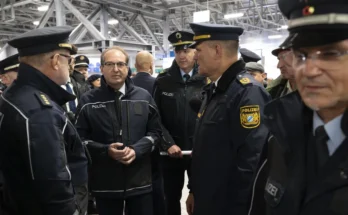The night in Kiev was shattered by one of the heaviest Russian bombardments on the Ukrainian capital since the start of the war: At least six people died and dozens were injured, fires broke out in several parts of the city, and residents huddled in rubble-strewn streets outside their apartment buildings. Fear swept across the country, as far away as Odessa, during raids that reportedly used 430 drones and 18 missiles, according to local authorities. In this all-out war, Ukraine responded by targeting, according to Moscow, the Novovoronezh nuclear power plant, on Russian territory, and one of the largest oil export terminals on the Black Sea.
In Kiev, residential buildings were attacked “almost in every district”, denounced the head of the military administration, Tymur Tkachenko. Local officials said most of the drones and missiles were shot down, but falling debris and fires damaged skyscrapers, schools, medical facilities and administrative buildings in nine districts. The six victims were all counted in an apartment building in the east, in Lisovyi, after a drone crashed, causing four floors to collapse. At least 34 people were injured across the city, including two children and a pregnant woman. Two more deaths were recorded after a bombing at a market in Chornomorsk, Odessa Oblast.
Once again, power outages were reported across the country. Moscow, as usual, called the “attacks on the facilities of Ukraine’s military and energy industrial complex” a “response to attacks on our infrastructure.” And it is precisely on this front that we see an intensification of Ukrainian attacks deep inside Russian territory, with the aim of rendering refineries, warehouses and oil pipelines out of commission and paralyzing the enemy’s main source of funding. This time damage was recorded at the port of Novorossiysk which was forced to stop crude oil exports. Local authorities also said there was damage to a boat and several residential buildings and four people were injured.
Ukraine, in the latest wave of cross-border attacks, also launched its own Long Neptune long-range cruise missile, Volodymyr Zelensky saidwithout specifying the goal. Arms supplies remain a major challenge for Kievwhich continues to make appeals in this direction to Western partners. However, regarding this matter, no specific indications emerged at the meeting of the defense ministers of the E5 group (including Italy) which took place in Berlin.
High Representative Kaja Kallas, responding to a question from a Ukrainian journalist, reminded that “the EU does not have anti-aircraft defense means and it is the states that do and it is up to them to decide what support to provide to Ukraine”. Meanwhile, German Minister Boris Pistorius remained silent about the possibility of supplying Taurus missiles to Kiev. In line with the Merz government’s decision not to communicate anything regarding this matter. Zelensky will try to achieve more during his next diplomatic tour of Europe.
On Monday he is expected at the Elysée by Emmanuel Macron, with whom he will visit the general staff of the “multinational power” that France and Germany are trying to set up in light of a possible ceasefire with Russia. According to Paris, this structure, created by a coalition of the willing, can count on 35 countries besides Kiev, and its general staff is already capable of “deploying forces after the ceasefire”. Zelensky will also fly to Athens and then to Madrid. Among the mission topics scheduled for Sunday, according to Greek government sources, will be the so-called Vertical Corridor, an infrastructure network aimed at supplying Kiev, transporting natural gas imported from the United States to Greek ports across the Balkans.


Reproduction protected by law © Copyright ANSA



